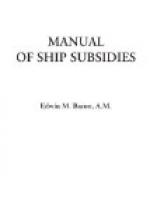Thereupon resort was had to another Extra-Parliamentary commission to frame another system. The result was a law of 1906 (April), which separated the shipbuilder from the shipowner. The provisions for the construction bounty were redrawn with the object, as Professor Viallates explains,[CC] “not only to equalize the customs duties affecting the materials employed, but also to give the builders a compensation sufficient to enable them to concede to the French shipowners the same prices as foreign builders.” The rates were thus fixed on gross measurement: for iron and steel steamships, one hundred and forty-five francs per ton; for sailing-ships, ninety-five francs per ton: these bounties to decrease annually to four francs and fifty centimes for steamships and three francs ninety centimes for sailing-ships during the first ten years of the law’s application, thereafter to stand at one hundred francs and sixty-five francs, respectively; for engines and auxiliary apparatus, twenty-seven francs fifty centimes per hundred kilograms. The navigation bounty to owners of French or foreign-built ships under the French flag, was calculated per day of actual running: for steamships, four centimes per ton gross up to 3000 tons; three centimes more up to 6000; two more to 6000 and above; for sailing-ships, three centimes per ton up to 500 tons, two more up to 1000, and one more to 1000 and above. This bounty to continue for the first twelve years of the law. The provisions for fostering speed development in steamships excluded from compensation those making on trial, half laden, less than nine knots, in place of ten in the previous law; reduced the rate to fifteen per cent of the bounty for those showing more than nine and less than ten knots; and increased this rate by ten per cent for those making at least fourteen knots, by twenty-five per cent for fifteen knots, and thirty per cent for sixteen knots. The extra bounty equal to twenty-five per cent of the regular navigation bounty to steamships constructed on plans approved by the Navy Department, and the provision making all merchant ships subject to requisition by the Government in case of war, were retained as in previous laws.[CD] This is the law at present in force.
The total cost of the French bounty system in the twenty-four years from its establishment with the law of 1881 to 1904, when the law of 1902 had practically run out, was in round numbers upward of three hundred and eighty-one million francs. Professor Viallates shows that the new law of 1906 would absorb during the first seven years of its application, upward of eighty-four million francs.[CE]
These construction and navigation bounties are exclusive of the subventions to steamships for carrying the mails. The establishment of the French postal ocean steamship subsidy system dates back to 1857, when a contract was made with the Union Maritime Company for a service to New York, Mexico, and the West Indies. The assertion is made by Professor Meeker that the French postal subventions paid “ostensibly for the furtherance of the mails,” are “both greater in amount and more influential upon shipbuilding, navigation, and commerce than are the general premiums upon shipbuilding and navigation."[CF] Says Viallates:




